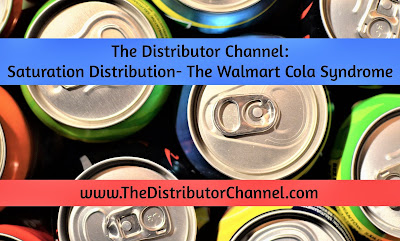Saturation Distribution: The Walmart Cola Syndrome
 What happens when every distributor in town represents
the same manufacturer? Extending this
thought, let’s assume at least a few of these distributors “sell” several of
this manufacturer’s competitors.
What happens when every distributor in town represents
the same manufacturer? Extending this
thought, let’s assume at least a few of these distributors “sell” several of
this manufacturer’s competitors.
To better understand the situation, let’s change the
scenario up a bit and take a trip to America’s number one retailer,
Walmart. Wandering through the megastore,
we find ourselves in an aisle containing colas and other soft drinks. Looking around we see Coke, Pepsi and over a
half dozen other brands, including a “house brand” named after the iconic Sam
Walton. Walmart has them all.
Does this giant retailer sell a lot of cola? If you consider “selling” as a transaction,
the answer is yes. However, if you count
“selling” as an activity where users are convinced to by one brand over another,
the answer is a definitive no. The truth
is, Walmart doesn’t care which brand you buy as long as you conduct your
transaction within their walls.
What does this mean for a cola manufacturer? All active selling must occur before the
visit to the local megastore. This
explains why Coca-Cola spent $5.8 Billion on advertising in 2018. Demand and all active selling functions are
handled by the manufacturer and the retailer simply provides the delivery
mechanism.
To capture those customers who are not completely sold on
a specific brand, the manufacturers provide incentives to the retailer to
capture preferential product shelf placement.
This explains the large endcaps and special islands featuring the brand that
pays the most for the privilege of exclusive placement. But again, the manufacture funds the selling
activity.
So how does this tie into distributors?
Some Mega-distributors are working to position themselves
as the one-stop shop of their industry.
Like Walmart, they have every brand available and do little “active
selling” on behalf of the manufacturers they sell.
Knowledge-based distributors appear to have taken a
different approach. They work hand in
glove with their supply-partners to find new applications, grow the market and,
very importantly, convert customers over to the products provided by their
supply-partners.
There is a difference in the type of sales activities and
the expertise required to work the model.
And, there is a major difference in the cost of selling. When manufacturers lose sight of this
difference, something bad happens; the knowledge-based distributor quits
“actively selling” these products.
Manufacturers need to understand the difference and
ensure their vision isn’t clouded by the volume of orders coming from the
Mega-distributors. Conversions, new
applications and technical support feed future sales for manufacturers
regardless of who does the work.
With this in mind, I would like to ask the following questions
of manufacturers:
- What are the cost ramifications of taking on all the selling, specification and troubleshooting work currently handled by the distributors?
- Are you counting on distributors to actively sell your products? (Hint, this model will not provide the results you desire.)
- If some of your distributors support only your product, should they be additionally compensated through tiering or additional gross margin tied to supporting only your company’s products?
- Do you have volume-based rebates or other programs that encourage distributors to overly discount or dump products into adjoining distributors’ territories?
A final word on distribution strategy
Do you have a specific strategy or does your policy
toward distribution just happen? The
business model for the distribution business has changed much in the past
decade. Is it time to rethink your
plan?
Drop us a line, we’d love to hear your thoughts…
Frank Hurttte is the Founding Partner of River Heights Consulting. He combines the battle scars of 28 years of front line "in the trenches" experience with over 13 years of service to knowledge-based distributors and their manufacturer partners.
Email or call today for a free 30-minute consultation!





Comments